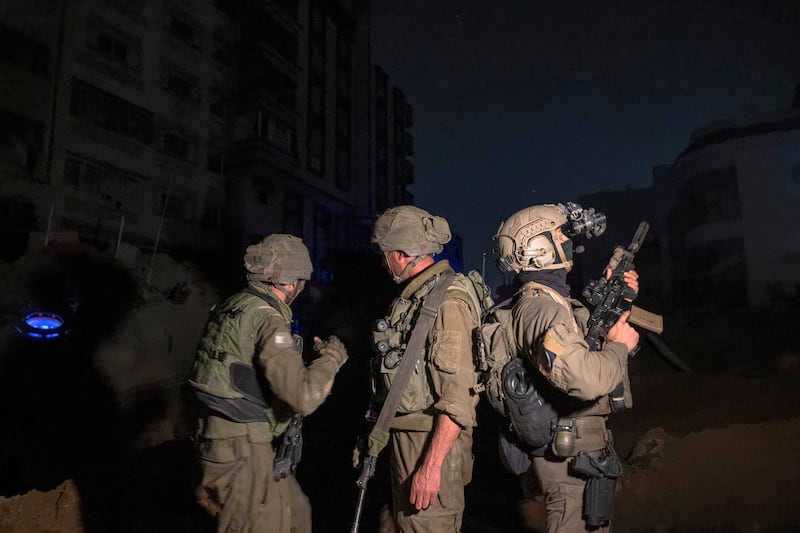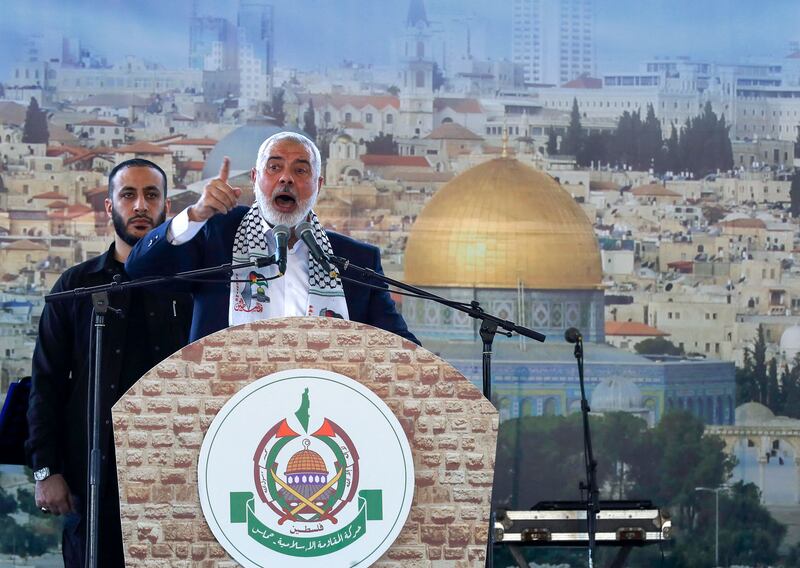On the 14th floor of Israeli military headquarters in Tel Aviv, high up in the defence minister’s office, a large pyramid adorns the wall made up of images of Hamas’s top ranks. The title: “Status of leadership assassinations.”
After five months of ferocious conflict in Gaza, those still alive greatly outnumber the mostly mid-ranking commanders whose fate is illustrated by a giant red X across their faces.
At the top – and still decidedly active – are Yahya Sinwar, Mohammed Deif and the handful of other leaders responsible for Hamas’s devastating October 7th attack that killed 1,200 people and triggered the war.
But the Xs on the pyramid are gradually spreading, just as Hamas’s fighting options appear to be dwindling. Israel is trying to confirm reports that Marwan Issa, the Hamas number-three in Gaza known as “the shadow man”, was killed in an air strike over the weekend.
READ MORE
Moreover, the quasi-state in Gaza that Hamas used to rule is wrecked, its forces are decimated and the strip’s population is enduring a deepening humanitarian catastrophe.

Israel has yet to achieve all its wartime goals. But for Hamas, an Islamist militant group founded to destroy the Jewish state, victory now has largely narrowed to one thing: survival.
“Let’s assume that all of Gaza lies in ruins, and someone will stand there left from Hamas, a wounded soldier, and will raise a Hamas flag – they’ve won the war,” said Micha Kobi, a retired former senior official in Israel’s Shin Bet security agency. “That’s what they believe.”
[ War on Hamas galvanises Israelis in quest for ‘total victory’Opens in new window ]
That too is the challenge for Binyamin Netanyahu, who has repeatedly vowed to “eliminate” Hamas. As long as the group’s top leadership and fighters remain at large, the Israeli premier will fall short of his call for “total victory” – and risk being viewed as a failure by many in Israel.
It underscores the challenge the US, Qatar and Egypt face as they struggle to negotiate a deal to halt the fighting and secure the release of more than 130 Israeli hostages still held in Gaza.
Hamas insists that any arrangement end with a permanent ceasefire and the withdrawal of Israeli troops from the strip – moves that could provide the battered group with a lifeline as it faces its gravest threat.

Yet Netanyahu has repeatedly rejected such demands, insisting that Israel would only pause its offensive to free the hostages. After that, it would renew its relentless pursuit of Sinwar and the Hamas leadership, whatever it takes in Gaza.
“It feels like a game of chicken and the question is who swerves first,” said an Arab diplomat.
From its humble roots in the slums and mosques of Gaza in the 1980s, Hamas underwent a steady rise in power and prominence – in the 1990s as a militant group violently opposed to the Israeli-Palestinian peace process, then more recently as the undisputed ruler of the coastal enclave.
There is little doubt, however, that after months of bombardment by air, land and sea, the overall picture for Hamas is grim, say Palestinian analysts, Israeli security officials and regional diplomats.
Estimates of Hamas’s strength are notoriously difficult. But according to Israeli intelligence assessments, more than 18 of the Islamist militant group’s 24 battalions have been dismantled as organised fighting forces, and about half of its 40,000 fighters have either been killed or wounded. Active Hamas fighters have melted away into small guerrilla cells, emerging to fire rocket-propelled grenades or place explosive devices.
Hamas, meanwhile, has reportedly said it has only lost 6,000 fighters. Whatever its numbers, US intelligence analysts foresee Hamas being able to continue a “lingering armed resistance for years to come”, using its underground tunnel network to “hide, regain strength and surprise Israeli forces”.

“Does Hamas still exist militarily? Yes,” said one senior Israeli military official. “Is it organised? No. The path to completely dismantling them goes on.”
The group’s civil control over northern Gaza and large parts of the south has certainly been eroded. Armed gangs are growing in number, while law and order has broken down across the devastated enclave, where more than 31,000 have been killed and 80 per cent of Gaza’s 2.3 million residents have been forced from their homes since Israel launched its offensive, according to Palestinian health authorities.
The bulk of the remaining Hamas battalions, according to the senior Israeli military official, have retreated to the southern city of Rafah and the refugee camps of Deir al Balah and Nusseirat in central Gaza.
Israel has repeatedly said that it plans to expand its offensive to Rafah, despite international warnings that it would have a disastrous impact on the 1.5 milion people who have sought sanctuary in the city.
And yet, despite all the devastation, Hamas officials continue to strike a defiant tone in public, speaking about Israel’s “impotence” and the “steadfastness”, or “sumud”, of its fighters.
Ismail Haniyeh, Hamas’s Doha-based political leader, said in a televised speech last month that Israel had achieved nothing but “killing children and women and old people and causing destruction”. “This is what will await it in Rafah militarily,” he warned.

Hamas’s fighters on the ground think “they are doing well militarily”, said the Arab diplomat, simply by holding out against one of the world’s most sophisticated armies in what has already been the longest Arab-Israeli war in decades.
Even so, with “their families and friends suffering”, he said there was no doubt pressure was growing to reach a ceasefire and alleviate the dire conditions for civilians.
“The key is how they react to pressure,” said the diplomat. “With groups like Hamas, in general, if you push too hard you will not get the reaction you want.”
Some analysts believe Hamas’s insistence on a permanent ceasefire as part of a hostage deal is a sign of the desperate situation in which the group finds itself.
“This isn’t about helping civilians [in Gaza] but about making the resumption of the war [by Israel] more difficult,” said Ibrahim Dalalsha, head of the Ramallah-based Horizon Center think-tank.
For this reason, say regional diplomats and analysts, Hamas is holding out for nothing less than a full Israeli withdrawal, the return of more than one million displaced people to north Gaza and the mass entry into the enclave of aid and semi-permanent shelters.
With both sides playing hardball, Hamas leaders in Gaza are aware their only “insurance policy” and leverage in the talks are the hostages, said Dalalsha.
This is why they have “become almost suicidal vis-a-vis the negotiations, with this maximalist position”, he said. “They know that if the war resumes and they’ve released the hostages, they’ll be finished,” he added.
Yezid Sayigh, a Beirut-based fellow at the Carnegie Endowment for International Peace and the author of a book on the Palestinian armed struggle, said the group’s predicament stemmed from its catastrophic miscalculation over the real balance of military power.
The bloody October 7th attacks struck deep inside Israel on a scale even Hamas did not think possible. But it also laid bare what Sayigh called the group’s “delusion” that the cross-border raid would trigger uprisings against Israel across the Middle East – and thereby limit the war or tip the balance.
“There’s a certain kind of nihilism [in the Hamas leadership] – that whether civilians died or not ... was not something they seem to have actually thought mattered,” Sayigh added.
Even Hamas may be realising its 17-year run as Gaza’s ruling power may be over. Already, according to multiple people familiar with regional diplomacy, Hamas officials have engaged in talks to allow the West Bank-based Palestinian Authority to reassert control over Gaza through an “ad hoc leadership committee” or newly formed technocratic government.
Survival, according to analysts, may ultimately only be possible for Hamas by reverting to its early roots: a resistance movement with an underground militant wing and religious social services network.
“Hamas has lost governance in Gaza but they’re still looking for political survival as an organisation,” said Dalalsha. “They’re not idiots. They see the needs of Gaza and realise the public and international community won’t accept them again.” – Copyright The Financial Times Limited 2024
- Sign up for push alerts and have the best news, analysis and comment delivered directly to your phone
- Find The Irish Times on WhatsApp and stay up to date
- Our In The News podcast is now published daily – Find the latest episode here





















